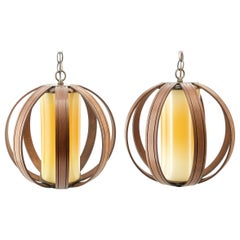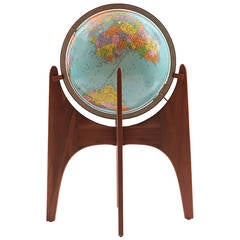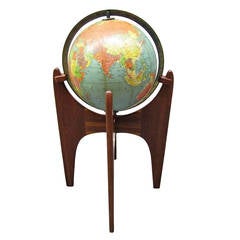Adrian Pearsall Globe
1960s Vintage Bentwood Globe Pendant Lamp Swag Light Cabin Modern Lodge Lantern
By Adrian Pearsall
Located in Hyattsville, MD
A pair of wonderful and high quality 1960s American-made walnut stained pendant lamps. New wiring has been installed. About 12 feet of cord and chain with a wall plug at the end for ...
Category
Vintage 1960s American Mid-Century Modern Lanterns
Materials
Wood
$1,198 Sale Price / set
60% Off
H 13 in Dm 14 in
Recent Sales
Beautiful Walnut & Brass Globe by Adrian Pearsall
By Adrian Pearsall
Located in Phoenix, AZ
Beautiful walnut and brass globe by Adrian Pearsall circa late 1950's. this sculptural example
Category
Vintage 1950s American Globes
Handsome, Mid-century Modern Adrian Pearsall Solid Walnut World Globe
By Adrian Pearsall
Located in Pemberton, NJ
Handsome Adrian Pearsall solid walnut world globe. This Replogle globe from the 1960s rests in a
Category
Vintage 1960s American Mid-Century Modern Globes
Materials
Brass
Vintage Adrian Pearsall for Craft Associates Illuminated Globe on Walnut Stand
By Craft Associates, Adrian Pearsall
Located in Brooklyn, NY
Model #1898-G16 globe circa 1960 USA designed by Adrian Pearsall for Craft Associates. 16" Replogle
Category
Vintage 1960s American Mid-Century Modern Globes
Materials
Brass
H 35 in W 22.75 in L 35 in
Adrian Pearsall Globe
By Adrian Pearsall
Located in Cincinnati, OH
A light up Pearsall globe sitting on a solid sculptural walnut base, brass ring surrounds the globe
Category
Mid-20th Century American Mid-Century Modern Globes
Materials
Walnut
Adrian Pearsall Globe
Located in Asbury Park, NJ
Appearing to float, this wonderfully designed, Pearsall-esque base holds a classic Replogle globe
Category
Vintage 1960s American Mid-Century Modern Globes
Vintage Adrian Pearsall Mid-Century Modern illuminated Globe Craft Associates
By Adrian Pearsall
Located in West Palm Beach, FL
Vintage 1960s Mid-Century Modern illuminated globe by Adrian Pearsall for Craft Associates. Same
Category
Vintage 1960s American Globes
Materials
Wood
H 33 in W 22 in D 22 in
Adrian Pearsall Stand with Vintage Replogle Illuminated Globe
By Replogle Globes
Located in Mexico City, DF
designer Adrian Pearsall (1925-2011). 2 years after receiving a degree in architectural engineering
Category
20th Century American Globes
Materials
Metal
Globe Light by Adrian Pearsall
By Adrian Pearsall
Located in Tarrytown, NY
Plastic globe on a wood base recently refinished in ebonized color.
Category
Vintage 1960s American Floor Lamps
1960 Adrian Pearsall Illuminating Globe with Stand
By Adrian Pearsall
Located in Hudson, NY
Walnut base in great condition. Globe has some browning and areas of loose and missing paper. Still
Category
Vintage 1960s American Mid-Century Modern Globes
Materials
Brass
Get Updated with New Arrivals
Save "Adrian Pearsall Globe", and we’ll notify you when there are new listings in this category.
More Ways To Browse
Adrian Pearsall Style Lamp
Glass Pitcher Poland
Goldscheider Butterfly Dancer
Gorham Sterling 1897
Gorilla Floor Lamp
Goryeo Bowl
Gravity Clock
Green Handkerchief Vase
Greyhound Figurine
Guan Yu
Guatemala Pot
Gucci Porcelain Ashtray
Guilt Sculpture
Gunnar Nylund Fish
Haberdashery Display Cabinet
Hagenauer African
Hagenauer Dancer
Half Doll Powder


